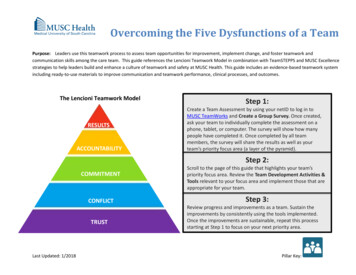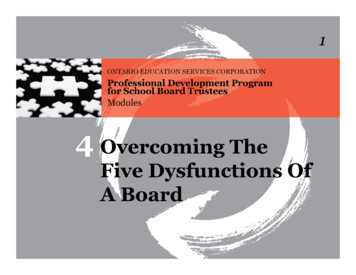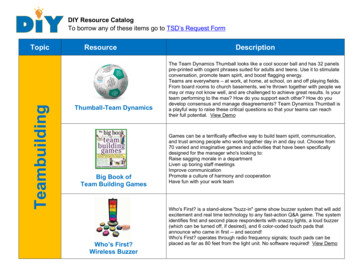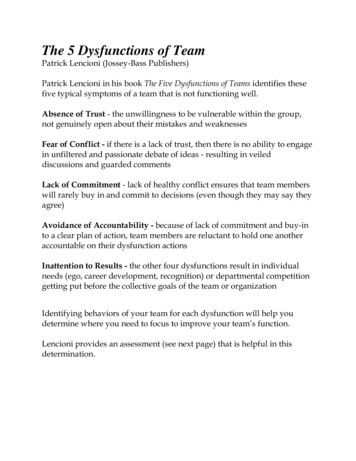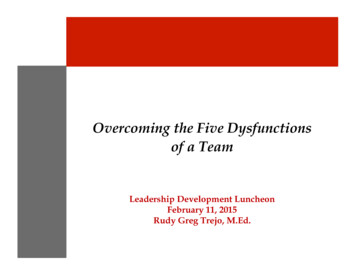
Transcription
Overcoming the Five Dysfunctionsof a TeamLeadership Development LuncheonFebruary 11, 2015Rudy Greg Trejo, M.Ed.
FiveDysfunctionsOverviewRudy Trejo, M.Ed.Assistant Director of Student Activities forStudent Government Leadership &ASG AdvisorForth Year at ArkansasOversees Student GovernmentChair, SEC Student Government AdvisorsBoard
FiveDysfunctionsOverviewThank You for Taking Up The Responsibilityof Leadership.
FiveDysfunctionsPurposeThe purpose of this model issimple: to provide managers, teamleaders, consultants, studentleaders, and others with apractical tool for helpingimplement successful strategies inensuring maximum growth andachievement.
FiveDysfunctionsOverview
FiveDysfunctionsOverviewAbsence of TrustAbsence of trust—unwilling to be vulnerable within the group.Members of teams with an absence of trust 1. Conceal their weaknesses and mistakes from one another.2. Hesitate to ask for help or provide constructive feedback.3. Hesitate to offer help outside their own areas of responsibility.4. Jump to conclusions about the intentions and aptitudes ofothers without attempting to clarify them.5. Fails to recognize and tap into one another’s skills andexperiences.6. Waste time and energy managing their behaviors for effect.7. Hold grudges.8. Dread meetings and find reasons to avoid spending timetogether.
FiveDysfunctionsOverviewAbsence of TrustMembers of great teams trust one another on afundamental, emotional level, and they arecomfortable being vulnerable with each otherabout their weaknesses, mistakes, fears, andbehaviors. They get straight to the pointbecause they can be completely open with oneanother, without filters.Trust is the fundamental foundation ofteamwork, building trust takes time, and it I snever complete, it must be maintained.
FiveDysfunctionsOverview
FiveDysfunctionsOverviewFear of ConflictFear of conflict—seeking artificial harmony over constructivepassionate debate.Members of teams that fear conflict:1. Have boring meetings.2. Create environments where back-channel politics and personalattacks thrive.3. Ignore controversial topics that are critical to team success.4. Fail to tap into all the opinions and perspectives of teammembers.5. Waste time and energy with posturing and interpersonal riskmanagement.
FiveDysfunctionsOverviewFear of ConflictTeams that trust one another are not afraid toengage in passionate dialogue around issuesand decisions that are key to the organization’ssuccess. They do not hesitate to disagree with,challenge, and question one another, all in thespirit of finding the best answers, discoveringthe truth, and making great decisions.Good conflict among team members requirestrust, even among the best teams, conflict can beuncomfortable, it must be discussed whatprocess is.
FiveDysfunctionsOverview
FiveDysfunctionsOverviewLack ofCommitmentLack of commitment—feigning buy-in for group decisions createsambiguity throughout the organizationMembers of teams that fail to commit:1. Create ambiguity among the team about direction and priority.2. Watches windows of opportunity close due to excessiveanalysis and unnecessary delay.3. Breeds lack of confidence and fear of failure.4. Revisits discussions and decisions again and again.5. Encourages second-guessing among team members.
FiveDysfunctionsOverviewLack ofCommitmentTeams that engage in unfiltered conflict areable to achieve genuine buy-in aroundimportant decisions, even when variousmembers of the team initially disagree. That’sbecause they ensure that all opinions and ideasare put on the table and considered, givingconfidence to team members that no stone hasbeen left unturned.Commitment requires clarity and buy-in, butdoes not require consensus.
FiveDysfunctionsOverview
FiveDysfunctionsOverviewAvoidance ofAccountabilityAvoidance of accountability—ducking the responsibility to callpeers on counterproductive behavior which sets low standardsMembers of teams that avoids accountability:1. Creates resentment among team members who have differentstandards of performance.2. Encourages mediocrity.3. Misses deadlines and key deliverables.4. Places an undue burden on the team leader as the sole sourceof discipline.
FiveDysfunctionsOverviewAvoidance ofAccountabilityTeams that commit to decisions and standardsof performance do not hesitate to hold oneanother accountable for adhering to thosedecisions and standards. What is more, theydon’t rely on the team leader as the primarysource of accountability, they go directly totheir peers.Accountability occurs directly among peers, andthe leader must be willing to confront friendsand peers. Accountability should occurfrequently during meetings and following up ongoals.
FiveDysfunctionsOverview
FiveDysfunctionsOverviewInattention toResultsInattention to results—focusing on personal success, status andego before team successMembers of teams that are not focused on results:1. Stagnates/fails to grow.2. Rarely defeats competitors.3. Loses achievement-oriented student leaders.4. Encourages team members to focus on their own intentionsand personal goals.5. Is easily distracted.
FiveDysfunctionsOverviewInattention toResultsTeams that trust one another, engage inconflict, commit to decisions, and hold oneanother accountable are very likely to set asidetheir individual needs and agendas and focusalmost exclusively on what is best of the team.They do not give in to the temptations to placetheir organization, personal aspirations, or egodriven status ahead of the collective results thatdefine team success.A great team will accomplish the goals it set outby prioritizing, staying focus, and puttingindividual needs under group goals.
FiveDysfunctionsOverview
FiveDysfunctionsOverviewENGAGESERVEGROW
More Information:The Five Dysfunctions of a TeamBy, Patrick LencioniFINISHWEWHATSTARTED
Overcoming the Five Dysfunctions of aTeamLeadership Development LuncheonFebruary 11, 2015
Five Dysfunctions Overview Lack of commitment—feigning buy-in for group decisions creates ambiguity throughout the organization Members of teams that fail to commit: 1. Create ambiguity among the team about direction and priority. 2. Watches windows of opportunity close due to excessive analysis and unnecessary delay. 3.




